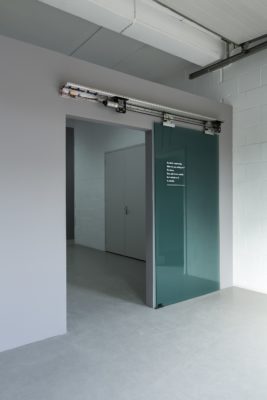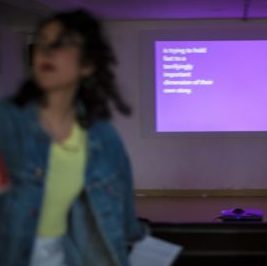Search
To search for an exact match, type the word or phrase you want in quotation marks.
A*DESK has been offering since 2002 contents about criticism and contemporary art. A*DESK has become consolidated thanks to all those who have believed in the project, all those who have followed us, debating, participating and collaborating. Many people have collaborated with A*DESK, and continue to do so. Their efforts, knowledge and belief in the project are what make it grow internationally. At A*DESK we have also generated work for over one hundred professionals in culture, from small collaborations with reviews and classes, to more prolonged and intense collaborations.
At A*DESK we believe in the need for free and universal access to culture and knowledge. We want to carry on being independent, remaining open to more ideas and opinions. If you believe in A*DESK, we need your backing to be able to continue. You can now participate in the project by supporting it. You can choose how much you want to contribute to the project.
You can decide how much you want to bring to the project.

The symbolic uses of doors are often only noticeable when they don’t work as we expect. Doors are thresholds, entrance or exit. They delimit private and public spaces. Also, those of production and leisure. They give access to hidden places or rather conceal them. They connect the world of the imaginary and the real. Yet, if doors don’t open or close when we need them to do so, if they are stuck or automatically regulated by unfamiliar rhythms, they change the meaning of what they symbolize. The first solo exhibition of Stephan Blumenschein “Upon arrival and during our stay; leaving, leaving and leaving again” at P/////AKT Amsterdam, revolved around this and other symbologies of the door, especially in relation to the architecture of the space and during the opening. It also explored aspects of the art exhibition such as sound, time, and waiting. Blumenschein’s work played with 1, 2, or 3 doors that drew different encounters between people and architecture.
In this essay, I think together with Blumenschein’s work. I focus on his use of the door as an artistic object and how it relates to our current mediated world.
At the entrance of Blumenschein’s exhibition were two sliding glass doors. They opened and closed automatically. The one on the left had this message inscribed on it:
He asked. Impatiently.
What are you waiting for?
The doors.
They said. So we waited.
For a minute or 2.
4, actually.
Visitors waited outside the gallery until the doors opened and gave access to the inside. Three different rooms composed the gallery space. At the end was a little bar where people ran to get a drink before the doors closed again. At one point, every visitor must have been trapped inside or outside. If they didn’t, they didn’t see the exhibition.
Media theorist Bernhard Siegert wrote that “to step through a door means to subject oneself to the law of a symbolic order, a law that is established by means of the distinction of inside and outside.” The sliding doors at the entrance of P/////AKT were more than a distinction between inside and outside, they were a transition rather than a conjunction. They opened a new dialogue between spaces by showing a new temporality of the exhibition and opening. People had to wait either to see the show or to leave the gallery. The transparent material of the doors contributed to blurring the inside and outside limits. They allowed visitors to have sneaky looks inside the gallery while waiting. Thus, they also turned the street into a part of the opening by expanding the event to the exterior and back to the interior of the gallery.
The cultural historian Hillel Schwartz placed rhythm at the core of his research on the symbolic order brought by technology during late Modern times. He proposed industrialization didn’t represent a de-rhythmization, as if incorporating new technologies into everyday life disrupted human rhythms. Instead, industrialization was the calibration process of the machine’s rhythms to integrate them into life. Schwartz analyzed many technologies, the movement they produced and how they affected the human body. Among his examples was the passing from the use of the push and pull door to the automatic sliding door. New technologies granted new performative aspects to the architecture. They helped, for example, to control the streams of people at the entrance of shops, trains, the lift, or the office. He concluded that the tendency to substitute machine’s stiff and bumpy movements with fluid and sliding ones was the most common sign of technology’s adaptation to human rhythms, while also a form to control them.
Blumenschein’s sliding doors were automatically opened every few minutes. Visitors’ capacity to decide when to go inside was suspended and accommodated to the rhythm of the doors. However, more than controlling the stream of people at the opening, the sliding doors generated a new temporality choreographed by themselves. They created new encounters between the inside and outside of the gallery. Also, between people who happened to wait at the same time in the same place. As simple as a delay in the time we expected the door to open, radically changed the relationship between spaces and people, especially during the opening.
Photograph Charlott Markus
A push and pull door separated a space inside the gallery. Contrary to the entrance doors, it confronted the visitor with an ordinary wooden door without message written on it. It could be the door to a private room for the gallery staff or an entrance to a storage or archive. This time the visitor had to choose whether to open the door.
The space disclosed by this door was generously decorated, which contrasted with the minimalist style of the rest of the exhibition. There were chairs, a wooden bench, and an acupuncture mat. Also, a table with a record player and speakers. Blumenschein’s new vinyl “Hmm… 1, or 2 so metres. Inside” was on. The record included a track where Blumenschein reads a list of the things someone likes to listen to. Being in his room felt intimate, a step into the everyday life of someone. Like the door to this room, the track transcended the gallery space and connected the visitor to a more personal environment.
This ordinary door seemed to play the role of blurring the limits between private and public. The furniture, the music, and the fact that the door could be closed and thus isolate the room from the rest of the exhibition contributed to generate a cozy and familiar setting. After a while, visitors immersed themselves in the music. Yet, the presence of others, the fact that anyone could interrupt at any moment or leave the door open, did not make the space completely private. Like Marcel Duchamp’s Revolving Doors in his Paris apartment. The Revolving Doors consisted of a door that connected Duchamp’s studio, bathroom, and bedroom. This door rendered all spaces sharable and personal at the same time. Similarly, the visitor of the music room was subjected to the ambiguous coexistence of the public and the private spheres.
Photograph Charlott Markus
As part of the exhibition at P/////AKT, Blumenschein organized a performance on a boat. Once the visitors were sitting, one performer started the boat while the other hummed a song. We were given a text that they read. The performance text began by mentioning that “there are no doors in exhibition spaces.” Doors in galleries or museums have a function. They separate the art space from the street, the toilet, the storage, or the office. But the exhibition space is divided by absent doors. An opening or gap on the wall is enough to set apart rooms without interrupting the pace of the visitor. We were floating on a space without doors too.
The second part of the performance text guided us into someone’s inner dialogue, a rainy day, and a brief encounter between two people at a door. Absent doors suggest movements between thoughts, a passage rather than an interruption or a division. Like exhibition spaces or the boat sailing from P/////AKT to a small street harbor, absent doors guided the thoughts of the passengers. The text pointed out that doors bring “about relations wrapped in a rhythm that unfolds as I move through them, with them, always more than what is seen.”
Photograph Charlott Markus
The concept of absent doors resonates with the psychoanalytic interpretation of the door. As mentioned by Siegert, the door is the symbol between the real and the imaginary that allows us to separate and recognize both. The imaginary belongs to the inside of subjects and their dreams, while the outside is the real. When the symbolic is rejected, the real and the imaginary collapse. People project their dreams onto the outside, and the laws of reality are suspended. The boat where the performance took place didn’t have doors but the content of the text suggested many. Somehow, the performance enhanced the power of the absent door to blend the imaginary and the real.
Beyond specific uses of the door in the space, the exhibition “Upon arrival and during our stay; leaving, leaving and leaving again” materialized different forms of mediation. It explored how architectural elements such as doors transform the meaning and relationship between life spheres, spaces, people, and spaces and people.Transformations that are applicable to the exhibition space but also to everyday life. Blumenschein’s work suggests that the contemporary symbolic order of mediation has become ambiguous, unexpected, fluid, dematerialized, but always changing and expanding.
References
Badia, Montse (curator), Revolving Doors, apexart curatorial program, New York, 2001.
Schwartz, Hillel, “Torque: The New Kinaesthetics of the 20th Century”, in Incorporations, ed. Jonathan Crary and Sanford Kwinter, New York: Zone Books, 1992.
Siegert, Berhand, “Doors: On the Materiality of the Symbolic,” in Grey Room, April 2012.

Helena Grande writes, publishes, sometimes organizes exhibitions and projections, makes videos and a lot of autofiction. She is interested in everything that entangles scientific literature, poetry and the ordinary. You can find her in Amsterdam and at times in Madrid.
"A desk is a dangerous place from which to watch the world" (John Le Carré)